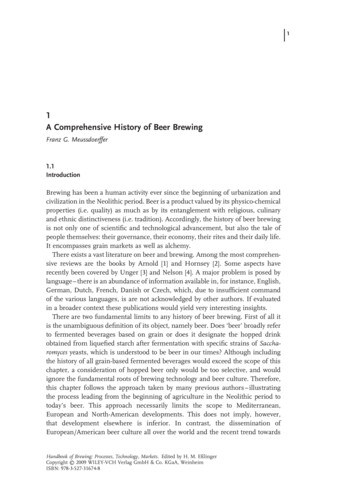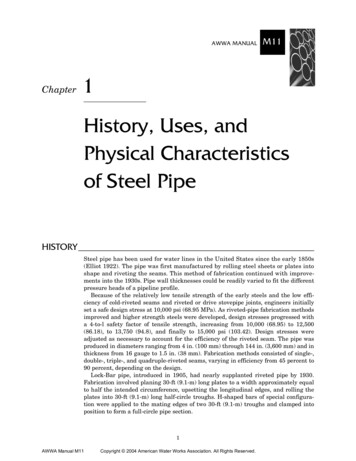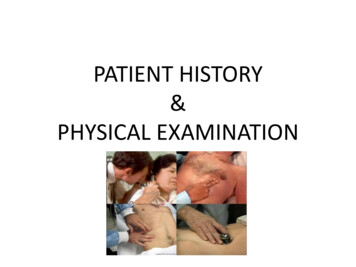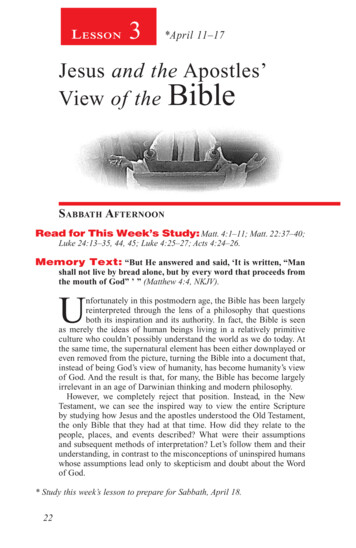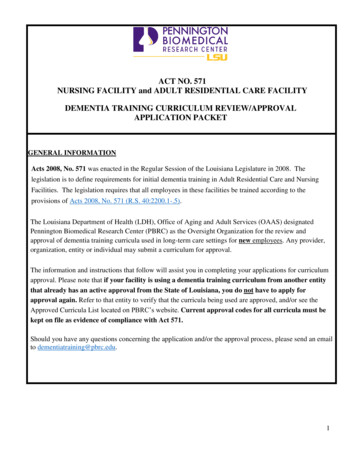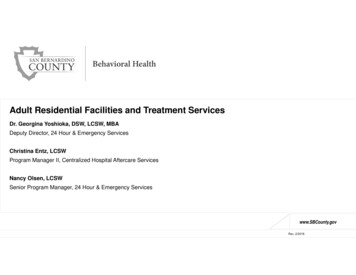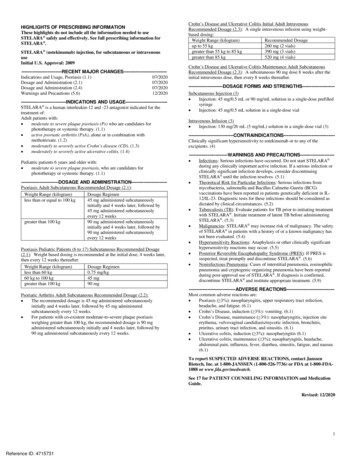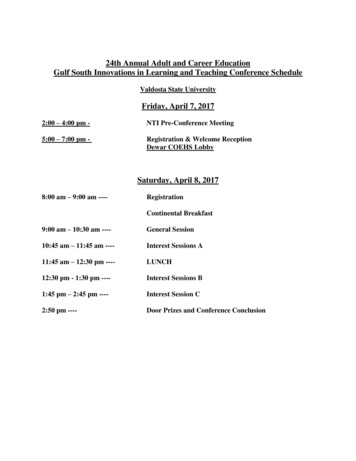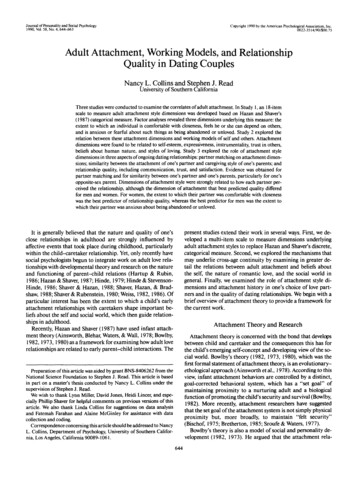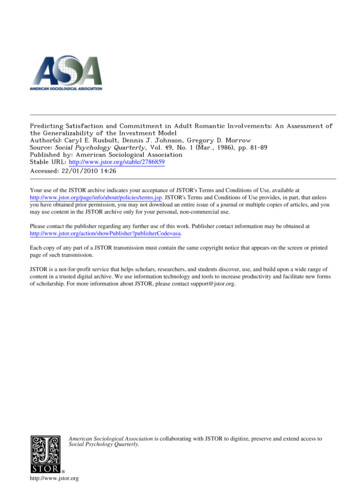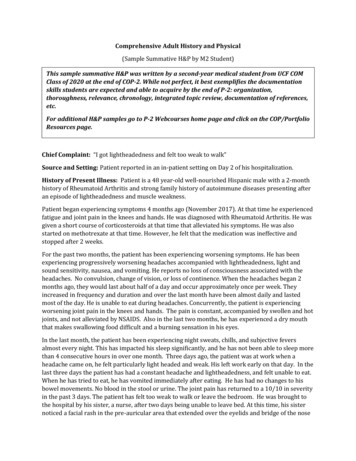
Transcription
Comprehensive Adult History and Physical(Sample Summative H&P by M2 Student)This sample summative H&P was written by a second‐year medical student from UCF COMClass of 2020 at the end of COP‐2. While not perfect, it best exemplifies the documentationskills students are expected and able to acquire by the end of P‐2: organization,thoroughness, relevance, chronology, integrated topic review, documentation of references,etc.For additional H&P samples go to P-2 Webcourses home page and click on the COP/PortfolioResources page.Chief Complaint: “I got lightheadedness and felt too weak to walk”Source and Setting: Patient reported in an in-patient setting on Day 2 of his hospitalization.History of Present Illness: Patient is a 48 year-old well-nourished Hispanic male with a 2-monthhistory of Rheumatoid Arthritis and strong family history of autoimmune diseases presenting afteran episode of lightheadedness and muscle weakness.Patient began experiencing symptoms 4 months ago (November 2017). At that time he experiencedfatigue and joint pain in the knees and hands. He was diagnosed with Rheumatoid Arthritis. He wasgiven a short course of corticosteroids at that time that alleviated his symptoms. He was alsostarted on methotrexate at that time. However, he felt that the medication was ineffective andstopped after 2 weeks.For the past two months, the patient has been experiencing worsening symptoms. He has beenexperiencing progressively worsening headaches accompanied with lightheadedness, light andsound sensitivity, nausea, and vomiting. He reports no loss of consciousness associated with theheadaches. No convulsion, change of vision, or loss of continence. When the headaches began 2months ago, they would last about half of a day and occur approximately once per week. Theyincreased in frequency and duration and over the last month have been almost daily and lastedmost of the day. He is unable to eat during headaches. Concurrently, the patient is experiencingworsening joint pain in the knees and hands. The pain is constant, accompanied by swollen and hotjoints, and not alleviated by NSAIDS. Also in the last two months, he has experienced a dry mouththat makes swallowing food difficult and a burning sensation in his eyes.In the last month, the patient has been experiencing night sweats, chills, and subjective feversalmost every night. This has impacted his sleep significantly, and he has not been able to sleep morethan 4 consecutive hours in over one month. Three days ago, the patient was at work when aheadache came on, he felt particularly light headed and weak. His left work early on that day. In thelast three days the patient has had a constant headache and lightheadedness, and felt unable to eat.When he has tried to eat, he has vomited immediately after eating. He has had no changes to hisbowel movements. No blood in the stool or urine. The joint pain has returned to a 10/10 in severityin the past 3 days. The patient has felt too weak to walk or leave the bedroom. He was brought tothe hospital by his sister, a nurse, after two days being unable to leave bed. At this time, his sisternoticed a facial rash in the pre-auricular area that extended over the eyelids and bridge of the nose
as well as cervical lymphadenopathy. The patient was unaware of these findings and did not knowhow long the rash or lymphadenopathy had been present for. At the time of the physical exam, therash was limited to the pre-auricular area.During the course of the past four months the patient reports a 36 pound unintentional weight lossand significant decrease to his muscle mass. He has been experiencing early satiety and nauseawhen he does eat. He reports no loss of sensation, pain, temperature, vibration. He does reportclumsiness, especially of the hands. He also reports a depressed mood and frustration with beingunable to work during his illness.Past Medical History:- Rheumatoid Arthritis, diagnosed January 2018. Patient was diagnosed when he presented to theemergency room with joint pain in the hands and knees. He was treated with corticosteroids andmethotrexate. The patient reported that the corticosteroids helped his symptoms significantly. Heonly continued on the methotrexate for 2 weeks, as he did not feel it helped with his symptoms.- Up to date with vaccinations, including yearly influenza vaccineSurgical History:-Nasal artery cauterization and clip placement - 2011Medications:- Ibuprofen PRN for headaches and joint pain.Allergies: No known drug allergies. No known environmental, food, or seasonal allergies.Family History:Father – Living aged 74- HTNMother- living aged 72 - HypothyroidismBrother – living aged 44 – VitiligoSister – living aged 40 – No known chronic health issues2 sons - living, aged 27 and 24 – No known chronic health issuesSocial History:Patient is a high school graduate, working as an electrician, living with his wife of 25 years and 2dogs. Patient feels safe and well-cared for in his home. He works as an electrician, a job with dailyphysical exertion that requires climbing ladders and the lifting of heavy objects. These aspects ofhis job have been impacted with his lightheadedness and muscle pain and weakness. Patient isconcerned about having to miss additional work due to his illness. Patient denies any history ofsmoking. Patient reports previously drinking alcohol socially -1-2 beers, 1-2 times per month however has ceased alcohol intake since the onset of symptoms 4 months ago. Patient denies anyrecreational drug use. Patient denies any exercise, though he feels that physically exerted everyday at his job. Patient reports a well-rounded non-vegetarian diet of mostly home cooked meals ofmeat and vegetables. Patient is sexually active with his wife and reports a happy and monogamousrelationship.Review of Systems:-Skin: Positive for facial in the pre-auricular area, see HPI. Negative for photosensitivity, easybruising, skin discoloration, new or changing moles, ulcers, hair loss, or dry or brittle nails, or dryskin.-Hematopoietic: Positive for fatigue, lightheadedness, headaches, enlarged non-tender lymph
nodes. Negative for tinnitus, fainting.-Head and Face: No pain, traumatic injury, ptosis, loss of sensation.-Ears: No changes to hearing, discharge from ears.-Eyes: Positive for burning sensation, See HPI. No changes to vision, inflammation, infections,double vision, tearing.-Mouth and Throat: See HPI, positive for dry mouth and dysphagia. No dental problems,hoarseness, or bleeding gums.-Nose and Sinus: No discharge, epistaxis, sinus pain, obstruction.-Respiratory: No cough, sputum, dyspnea, wheezing.-Cardiovascular: No chest pain, dyspnea, swelling of extremities, hypertension, exercise intolerance,or palpitations.-Gastrointestinal: Positive for anorexia, decreased appetite, nausea, vomiting. No PICA, heartburn,change in bowel habits or bowel texture. No blood in the stool.-Genital Tract: No discharge, pain, pruritus, history of sexually transmitted infections.-MSK: Positive for painful, hot, and tender joints with subjective swelling. See HPI-Nervous System: See HPI regarding recent lightheadedness. No tremor, ataxia, difficulty speaking,loss of sensation, seizures, changes in memory.-Endocrine: See HPI regarding fatigue. No tremor, heat or cold intolerance, polyuria, polydipsia,goiter.-Psychological: Positive for depressed mood. No nervousness, phobia, insomnia, memory loss,disorientation.Physical Exam:Vitals: T 98.5, HR 68, BP 126/85, RR 16.General Appearance: Patient is a ill-appearing, well-nourished man in no acute distress.Skin: Macular rash in the pre-auricular area. No pallor. Normal texture, normal turgor, warm, dry.Eyes: Normal pink mucosa with no signs of pallor, no scleral icterus.Neck: Lymphadenopathy in the anterior cervical chain and supraclavicular chain. Lymph nodeswere 4-5 mm and not fixed. No Lymphadenopathy in posterior cervical chain. No thyromegaly.Heart: PMI non-displaced and heart of normal size; no thrill or heaves, RRR, S1S2 with no S3 or S4.No murmurs, rubs, or gallops.Lungs: No increased work of breathing, lungs clear to auscultation bilaterally, no wheezes orcrackles.Extremities: Normal capillary refill, no edema, clubbing, cyanosisAbdomen: Non-distended, no scars, normoactive bowel sounds, no bruits, non-tender to palpation,no hepatosplenomegaly, no massesNeuro: Alert and oriented X 3. Strength of biceps, triceps, hand grip, finger spread, hip flexion, kneeflexion, and knee extension 4/5 bilaterally. Cranial Nerves II-XII were grossly intact. Tandem gaitwas normal symmetric. Sensation intact to light touch and sharp vs dull on distal arms and legs.Proprioception intact.Pertinent Diagnostic Tests:January 8 2018:- Autoimmune:ooPositive ANA ( 1:640)Positive Rheumatoid Factor (70, Normal 20)
--o Elevated CCPo Positive SS-Ao Positive for HLA Cass 1o Elevated Sedimentation Rate (46, Normal 0-15mm/hr)o Positive Double Stranded DNA Antibody ( 300, Normal 10)o Negative Smith Antibody, Negative Jo-1, Negative Scl-70Hematologic:o Decreased CD4 (147 cells/uL, Normal: 492-1656 cells/uL)o Decreased WBC (4.0, Normal: 4.1-10.4 x 10(3)/uL)o Decreased RBC (4.32, Normal: 4.4-5.6 x 10(6)/uL)o Normal Hemoglobin (13.9, Normal 13.7-16.7 g/dL)o Normal Hematocrit (41.3%, Normal 40.0-48.0%)Infectious (All Negative): Negative Hepatitis Panel (B surface antigen, B core IgM, Hepatitis C),Negative STI Panel (N Gonorrhoeae DNA, trachomatis DNA), Negative Parvovirus B19 IgG/IgM,Negative CytomegalovirusFebruary 27 2018:--Hematologic:o Elevated Lactate Dehydrogenase (333, Normal 140-271)o Elevated Creatinine Kinase (229, Normal: 30-223)o Decreased RBC (3.72x 10(6), Normal: 4.4-5.6 x 10(6)/uL)o Decreased Hemoglobin (11.7, Normal 13.7-16.7 g/dL)o Decreased Hematocrit (35.1%, Normal 40.0-48.0%)o Decreased WBC (3.7, Normal: 4.1-10.4 x 10(3)/uL)o Decreased Platelets (112, Normal: 145-355 x 10(3)/uL)Imaging:o CT showed chronic enlargement of the Parotid Glando Head CT came back with no abnormalitieso US showed bilateral neck, axilla, and groin lymphadenopathy. However, nodes shownormal morphology and normal fatty hilaProblem List:Joint PainUnintentional Weight Loss, Fever, Night SweatsEarly SatietyDry eye and MouthHeadaches with lightheadedness, nauseaLymphadenopathyFacial RashSummary Statement:In summary patient is a 48 year old Hispanic male with a 2 month history of Rheumatoid Arthritisand a strong family history of autoimmune disease, who presents with a four month history of jointpain and weakness, a 2 month history of headaches with lightheadedness and nausea, and a onemonth history of subjective fever, and night sweats alongside symptoms of burning eyes and drymouth, decreased RBC and Hemoglobin, and a CT with an enlarged parotid gland.
Assessment and Plan:Differential diagnosis includes: Most Likely: Sjӧgrens SyndromeAssessment: The patient has a personal history of autoimmune disease and a positive HLAgenotype. He was diagnosed with Rheumatoid arthritis 2 months ago. His presenting symptom ofbilateral joint pain in the knees and fingers paired with a positive RF, CCP, and decreased CD4 countmade this diagnosis very likely. Sjӧgrens Syndrome is very heavily associated with RheumatoidArthritis, estimated prevalence between 17-30%8 in those with previously diagnosed RheumatoidArthritis. The patient’s laboratory and imaging studies, including a positive SS-A, neck CT showingchronic enlargement of the Parotid Gland, paired with the symptom of dry mouth and a burningsensation of the eye, a possible manifestation of dry eyes, are suggestive of Sjӧgrens Syndrome.Another possible cause of the burning sensation is trigeminal neuralgia, a neurologicalmanifestation of Sjogren’s syndrome. However, this patient also presents with some of rarermanifestations of Sjӧgrens Syndrome. According to UpToDate: Clinical manifestations of Sjögren'ssyndrome: Extraglandular disease, normochromic normocytic anemia can be seen in up to 20% ofsjogrens patients. Further, “Patients with SS may exhibit abnormal counts in any cell line, andpatients with cytopenia often have involvement of more than one cell line“3. This hematologicmanifestation of disease accounts for many of the abnormal blood tests including the anemia andleukopenia. This anemia could be the underlying cause of the lightheadedness and muscleweakness. Further, a more rare manifestation of Sjӧgrens Syndrome, is autonomic neuropathy3.Autonomic neuropathy manifests as headache, lightheadedness, early satiety, vomiting, weight loss,and sweating abnormalities. The patient’s headaches with lightheadedness, as well as his GIsymptoms and night sweats can be explained by the neurological manifestations of Sjӧgren’ssyndrome. Finally, autoimmune diseases are often associated with cutaneous manifestations. Someof these, such as the malar rash of lupus are well defined, while others are ill defined. The preauricular rash can be seen as an atypical cutaneous presentation of Sjogren’s syndrome.Plan: A Schirmer test would help differentiate if the burning sensation in the eyes is due to dry eyesor another cause, possibly trigeminal neuralgia. Acutely, the patient should be started oncorticosteroids to treat the acute symptoms of Sjӧgrens syndrome. Long term, hydrochloroquine oran immunosuppressant may want to be considered. This should help with the joint pain andconstitutional symptoms. Monitoring of RBC and WBC should be continued to make sure theyreturn to normal ranges after this acute event. Alternative: Systemic Lupus Erythematosus (SLE)Assessment: SLE is another very possible diagnosis. The history of autoimmune diseases, pairedwith the SS-A and dsDNA can point us towards a diagnosis of Lupus. The anemia and leukopeniacan also be accounted for by SLE. However, SLE would not explain the dry mouth and burning eyes,nor would it explain the parotid gland involvement. However, the macular rash in the pre-auriculararea, which the sister described as extending over the eyelids and bridge of the nos
Surgical History: -Nasal artery cauterization and clip placement - 2011 Medications: - Ibuprofen PRN for headaches and joint pain. Allergies: No known drug allergies. No known environmental, food, or seasonal allergies. Family History: Father – Living aged 74- HTN Mother- living aged 72 - Hypothyroidism Brother – living aged 44 – VitiligoFile Size: 696KBPage Count: 6
